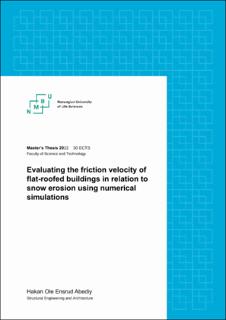| dc.contributor.advisor | Thiis, Thomas Kringlebotn | |
| dc.contributor.author | Abediy, Hakan Ole Ensrud | |
| dc.date.accessioned | 2022-11-21T13:33:59Z | |
| dc.date.available | 2022-11-21T13:33:59Z | |
| dc.date.issued | 2022 | |
| dc.identifier.uri | https://hdl.handle.net/11250/3033174 | |
| dc.description.abstract | Snow loads are often the most significant loads for large flat roof buildings in the Nordics. The relevant building code for snow loads for this area, EN-1991-1-3, conservatively oversimplifies the effect of wind on snow loads. Additionally, EN-1991-1-3 does not contain a direct method to calculate the design snow load for flat buildings exceeding 50 meters. The oversimplifications are intended to make engineers’ snow load calculations easy to perform. They also result in increased construction costs due to their conservative approach.
This study examines the friction velocities u∗ on the roof using 3D single-phase CFD simulations completed in ANSYS CFX. Outliers are labeled by use of the Modified Z method and then removed. Then the roofs’ median friction velocity is calculated based on the filtered dataset. Further analysis of the friction velocities is performed in Python.
This thesis examines two instances. In both cases, a power-law wind profile with α = 0.18 and α = 0.28, and the wind directions simulated are θ = 0◦, 22.5◦, 45◦. Case 1 is a 50x50 m square roof without a parapet and heights of 10,20 and 30 m. Case 2 is a square 50x50 m roof with a parapet at 10,20, and 30 m height. The parapet extends to a height of 0.5 meters and a width of 0.2 meters. Between the two cases, the difference in median friction velocities was negligible. The median friction velocity increases with height and varies significantly depending on the direction of the wind. The expressions for normalized friction velocity were calculated based on the CFD simulations.
The expressions obtained for the normalized friction velocity can be implemented in a future snow model to predict the roof’s design snow load more accurately. | en_US |
| dc.language.iso | eng | en_US |
| dc.publisher | Norwegian University of Life Sciences, Ås | en_US |
| dc.rights | Attribution-NonCommercial-NoDerivatives 4.0 Internasjonal | * |
| dc.rights.uri | http://creativecommons.org/licenses/by-nc-nd/4.0/deed.no | * |
| dc.title | Evaluating the friction velocity of flat-roofed buildings in relation to snow erosion using numerical simulations | en_US |
| dc.type | Master thesis | en_US |
| dc.description.localcode | M-BA | en_US |

